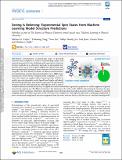Seeing Is Believing: Experimental Spin States from Machine Learning Model Structure Predictions
Author(s)
Taylor, Michael D.; Yang, Tzuhsiung; Lin, Sean; Nandy, Aditya; Janet, Jon Paul; Duan, Chenru; Kulik, Heather Janine; ... Show more Show less
DownloadPublished version (2.797Mb)
Publisher with Creative Commons License
Publisher with Creative Commons License
Creative Commons Attribution
Terms of use
Metadata
Show full item recordAbstract
Determination of ground-state spins of open-shell transition-metal complexes is critical to understanding catalytic and materials properties but also challenging with approximate electronic structure methods. As an alternative approach, we demonstrate how structure alone can be used to guide assignment of ground-state spin from experimentally determined crystal structures of transition-metal complexes. We first identify the limits of distance-based heuristics from distributions of metal-ligand bond lengths of over 2000 unique mononuclear Fe(II)/Fe(III) transition-metal complexes. To overcome these limits, we employ artificial neural networks (ANNs) to predict spin-state-dependent metal-ligand bond lengths and classify experimental ground-state spins based on agreement of experimental structures with the ANN predictions. Although the ANN is trained on hybrid density functional theory data, we exploit the method-insensitivity of geometric properties to enable assignment of ground states for the majority (ca. 80-90%) of structures. We demonstrate the utility of the ANN by data-mining the literature for spin-crossover (SCO) complexes, which have experimentally observed temperature-dependent geometric structure changes, by correctly assigning almost all (>95%) spin states in the 46 Fe(II) SCO complex set. This approach represents a promising complement to more conventional energy-based spin-state assignment from electronic structure theory at the low cost of a machine learning model.
Date issued
2020-03Department
Massachusetts Institute of Technology. Department of Chemical Engineering; Massachusetts Institute of Technology. Department of Materials Science and Engineering; Massachusetts Institute of Technology. Department of ChemistryJournal
The journal of physical chemistry. A
Publisher
American Chemical Society (ACS)
Citation
Taylor, Michael G. et al. “Seeing Is Believing: Experimental Spin States from Machine Learning Model Structure Predictions” The journal of physical chemistry. A, vol. 124, no. 16, 2020, pp. 3286-3299 © 2020 The Author(s)
Version: Final published version
ISSN
1089-5639